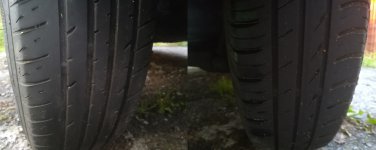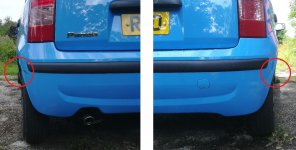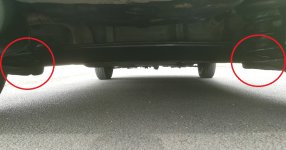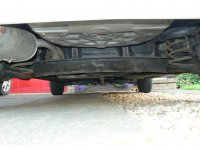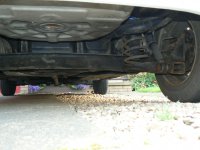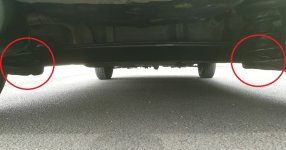There is distinct 'feathering' on the leading edge of the outside tread blocks, leading me to suspect excessive toe-in. The off side rear (Conti CEC3) shows the same symptoms, but nowhere near as much, and this tyre's about 1 year older.
In other good news, the fronts are fine (yay!), all tyres are 155/80 R13s, I keep them at 29psi front/26 rear (up to 29 with a heavy load). She brakes & handles fine, albeit with a very slight pull to the left when going straight ahead, I only really notice it on motorways.
A visual check from the rear, lining up the rear wheel until I could just see the rim, shows the NSR pointing towards the middle of the car, with more bodywork & front wheel visible on the left side compared to right
I measured -6mm across the front of the rear tyres compared to the rear, with a tape measure between the inner grooves at the highest point possible on the front & rear of the rear tyres.
I know this is not an accurate measurement of wheel alignment, but would I be right that this confirms my suspicion that excessive toe-in on the near side rear wheel is causing my car to eat this tyre this way?
If so, what next? I'm torn between:
1. Taking her for a 4-wheel alignment. I'm put off this by reading here (and on other threads/sites) that according to FIAT (and presumably most garages) there is no adjustment for toe/camber on the rear axle.
So whilst they could confirm what the issue is, they probably can't do anything about it.
2. Replacing rear bushes (possibly also springs/dampers?) to give an accurate baseline before making any further adjustments. I'm reluctant because, frankly, it seems like a lot of work and I have little faith it would help.
I fully appreciate that a 15 year-old car with 3 owners can reasonably be expected to show wear in the suspension & bushes, and it's not impossible it may even have taken a knock at some point. But my MOT has no advisories so I feel whilst the bushes might be past their best, they can't have deteriorated so much as to cause this amount of tyre wear, can they?
It also seems this problem isn't unknown on 169 Pandas, with some owners reporting it from new, so it could even be down to manufacturing tolerances?
Just to add a twist (beam) to this story, is it normal for the rear spring cups to be at different angles like this? The car was unladen on a level surface. Looks odd to me:
nsr toe 03.jpg
3. I'm intruigued by the references to the triangular mounting plates on the rear axle providing some degree of adjustment.
But I assume adjusting this wouldn't get my rear wheels parallel, and I already have signs that suggest toe-in on both rear wheels. If I decrease toe-in on the left this way, I assume it would increase on the right.
Also, it sounds tricky. I don't think I have the expertise or equipment to accurately monitor any adjustments I make this way.
4. I'm most tempted to try shimming the front two studs between the left rear hub and swing arm mounting plate, to bring the front of the NSR wheel outwards, and then get the alignment tested once I've got the rear wheels more or less parallel. Or just rotate the tyres & monitor tyre wear.
I understand this isn't a very accurate way of adjusting toe, but if I could just reduce the toe-in enough to alleviate the excessive tyre wear, it would be an improvement. Plus if it doesn't work I could easily undo this step.
Pugglt Auld Jock- if you're reading this, hello, I hope you're well and thank you for your wee essay on tyre wear and castor/camber/toe. It's great to have the benefit of your experience, and I found it very informative (I even read the whole thing!). Thanks also for your post on your home-made alignment tool (looks great, I don't care what the others say!). I don't think I could tackle such a thing myself just yet, but with three old cars to look after (of which the Panda is the whippersnapper by quite some margin), an accurate method of monitoring wheel alignment would be very useful. Your post has given me confidence that I could do this, with the right tools.
If I do go ahead and make adjustments myself, I'd like a better idea of what's going on at the four corners. I understand the Gunson Trakrite alignment guage is just for front wheels? Is there anything similar (not too expensive) that can measure rear alignment as well?
So I'm leaning (with negative camber of course) towards option 4. Any thoughts, please? Thanks for taking the time to read this, any advice would be greatly appreciated.


